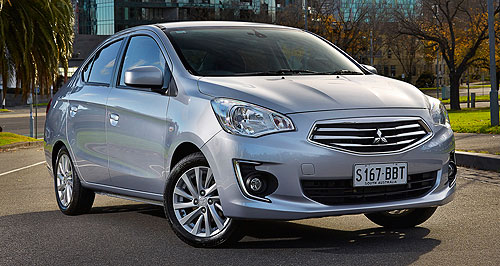News - Market Insight - Market Insight 2014Market insight: Micro cars almost invisibleGetting smaller: Mitsubishi’s Mirage is the micro-car champion, but even it is suffering a sales decline as buyers consider bigger vehicles. Baby car sales down 30 per cent as cheap petrol and discounting from above take toll11 Dec 2014 SALES of the smallest and cheapest breed of cars on the Australian market have plunged this year, victim of a perfect storm of conditions that include falling petrol prices and fierce market competition from above. Official VFACTS data shows micro car sales are down more than 30 per cent in the 11 months to the end of November – the biggest drop of any segment in the new-vehicle market that has slipped 2.2 per cent year to date. Once seen as potential growth segment due to climate change action and fears of rising fuel costs, the micro segment – populated mostly by hatchbacks powered by thrifty three-cylinder engines – now commands just 1.5 per cent of automotive sales. This compares with 9.7 per cent market share by the one-size-larger light-car segment and a whopping 22.6 per cent for the small-car class that includes Australia’s best sellers, the Toyota Corolla and Mazda3. The drop in micro car sales – from an average of 1906 a month in 2013 to 1340 a month this year – has coincided with cheaper petrol due to a global oversupply of oil in 2014. As always, motorists vote with their wallet, and because they are not being punished at the pump, they are willing to consider bigger cars with thirstier engines. The trend has been compounded by fierce discounting among light-car manufacturers, pushing their products down into micro price territory. As well, all these factors have prompted some manufacturers such as Volkswagen to reconsider participation in the micro segment, with models such as VW’s Up withdrawn from sale due to lack of viable volumes and wafer-thin margins. The biggest seller in the segment is also one of the freshest: Mitsubishi’s Mirage was launched in January last year, making it less than two years old. As well, the Thai-built hatch and sedan range was given a minor refresh in October, along with a price cut to just $11,490 (plus on-road costs) for the entry level ES hatch. But even Mirage sales have suffered this year, down almost 32 per cent, roughly in line with the segment, to 6155 units. The only serious winner in the segment has been the Fiat 500 that, thanks to sharper pricing and Italian cache, has forged ahead to the tune of 44.3 per cent to become the second-best-selling model in the segment, with 2757 sales year to date. In doing so, it has eclipsed the Nissan Micra and Suzuki Alto, which are both nearing the end of their life cycle. Micra sales in particular have suffered this year, down 46 per cent from 4023 units to the end of November in 2013 to 2168 this year. Nissan Australia originally was expecting to receive the new-generation Micra in late 2013, but delays have pushed it out to the first half of 2015. The Japanese importer will be hoping for a return to Micra’s glory days, such as 2011 when it sold 9509 of the little hatchbacks. Suzuki is also sweating on a new model to replace its Indian-built Alto. To be called Celerio, the Thai-built hatch is expected to land in about May to give the small-car specialist a much-needed boost. Sales of the five-year-old Alto have dipped 36 per cent this year, to 1698 sales for the first 11 months, placing the one-time class leader in fourth place. Although Volkswagen Group Australia (VGA) announced its decision to axe the Up back in April, residual stocks are still being sold, albeit in small numbers. In November, 12 of the sub-Polo hatchbacks found homes, bringing the 2014 tally to 321 – down 76.9 per cent on the same period last year. When it brought the guillotine down on Up, VGA said the price-competitiveness of the segment and need to constantly spend money to maintain volume could not be justified on a car with such small volume potential. Also, it did not help that Up did not offer an automatic transmission – an essential in Australia. Another micro car to bite the dust is the Chinese-made Chery J1 that, despite being billed as Australia’s cheapest car at $9990 driveaway, was discontinued in 2013 because it was not fitted with electronic stability control that became mandatory this year. Somehow, 10 J1s have been sold this year. Possibly the most disappointed micro car market contender is Holden, whose Korean-built Barina Spark has failed to set the segment alight, despite snappy styling and a lion badge. Holden dealers have shifted just 1174 units in 2014, down from 1782 last year. The problem for the Daewoo-based Spark is just across the showroom floor where a customer will find a ‘real’ Holden Barina – built on an Opel platform with considerably more cabin space – for just $1000 extra. Like other car companies, Holden might get salvation from a new model, with Opel’s Karl – called Viva in Vauxhall guise – a possible candidate to replace the Spark in a year or two. But until petrol prices rise and the price gap widens between micro and light cars, few manufacturers are going to plunge into the bottom end of the market with any sort of confidence.  Read more |
Click to shareMarket Insight articlesResearch Market Insight Motor industry news |



















Facebook Twitter Instagram